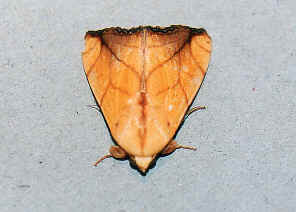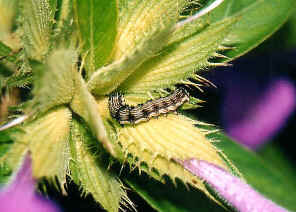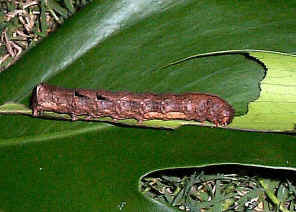Noctuid Moths - Family Noctuidae
This page contains pictures and information about moths and caterpillars in family NOCTUIDAE that we found in the Brisbane area, Queensland, Australia.

- Armyworm Caterpillar length 30mm
The Caterpillars of NOCTUIDAE are usually smooth, or with very little hairs. They are from small to large size. Most are active at night.
Some NOCTUIDAE caterpillar are called Cutworms, some
called Armyworms and some called Semi-loopers. Cutworms live in soil surface.
They bite off young plants at ground level and pull them into their burrow.
Armyworms eat their way across like an army on the march. Semi-loopers loop their bodies when moving as the
Caterpillars of the family GEOMETRIDAE.
Most NOCTUIDAE pupate in the soil but some pupate under
a leaf of their food plant.
The adults mainly fly at night. They usually feed on
nectar from flowers, some feed on ripe fruit. They are from small to large size.
Usually they are dull in colour, but some have colourful hindwings.
NOCTUIDAE is the largest family of moth. We found many of them in Brisbane and listed as follow.
Subfamily CATOCALINAE
- We found many moth species in this subfamily. They are listed in the separated page - CATOCALINAE.
Subfamily EUTELINAE
- Noctuid Moth
-

- Pataeta carbo, body length 25mm
- We found this moth inside our house. The caterpillar feeds on Eucalyptus.
Subfamily CHLOEPHORINAE
- Transverse Moths


- Xanthodes transversa, caterpillar length 50mm, adult wingspan 30mm
- We sometimes find this Transverse Moths caterpillars on our Hibiscus plants in our backyard. When small, the caterpillars are light green in colour. Later they develop yellow bands and black spots. The adult Transverse Moth is yellow in colour, with three brown arrow-shaped lines across each forewing. The back edges of the forewings are dark brown in colour. More pictures and information please click here.
Subfamily ACRONICTINAE - AMPHIPYRINAE
- The adults of this two subfamilies cannot not be readily separated from each other. Sometimes this two subfamilies are treated as one subfamily. We found many moth species in this combined subfamily. Details please see in the ACRONICTINAE - AMPHIPYRINAE page.
Subfamily AGARISTINAE
- Joseph's Coat Moth, Painted Vine Moth


Agarista agricola, caterpillar length 40mm - We found quite a number of those caterpillars feeding on grape vine in Daisy Hill during late summer. The caterpillars have alternate black and white bands with some orange bands. They have sparse black thick hairs. The adult moths are day flying, with black, red, pale blue and yellow colours.
- Native Budworm


- Helicoverpa punctigera, length
20mm
Moth, wingspan 40mm
- We sometimes found this caterpillar feeding on flower bud. We even found this caterpillar inside a strawberry. This Caterpillar has black dots and pattern of thin dark lines running along the body. Those lines are darker around the second and third segments. The adult moth is brown in colour. Click here for more information.
- We sometimes found this caterpillar feeding on flower bud. We even found this caterpillar inside a strawberry. This Caterpillar has black dots and pattern of thin dark lines running along the body. Those lines are darker around the second and third segments. The adult moth is brown in colour. Click here for more information.
Subfamily HELIOTHINAE
Unknown Noctuid Caterpillars
Followings are caterpillars that yet to be identified. Please advise if you known what are they.
- Dark-brown Unknown Caterpillar


- Caterpillar length 50mm
- The above caterpillar turn into a pupa, but this pupa never turn into a moth.
